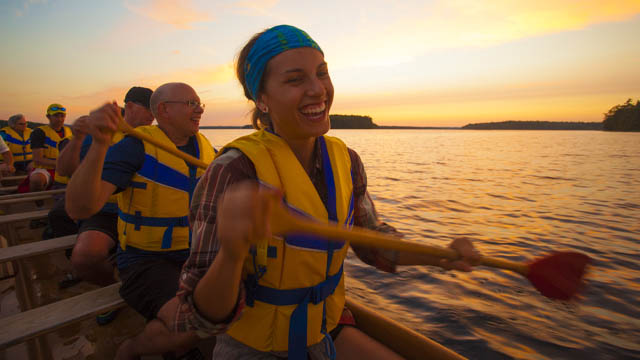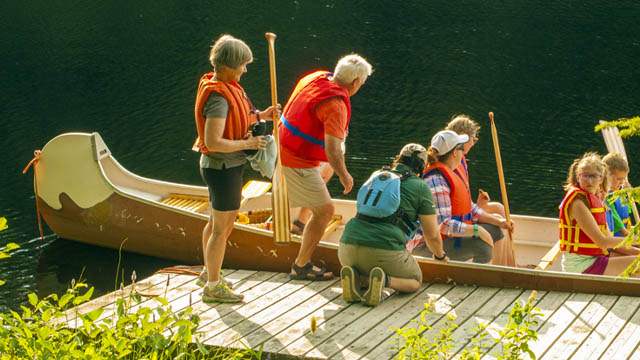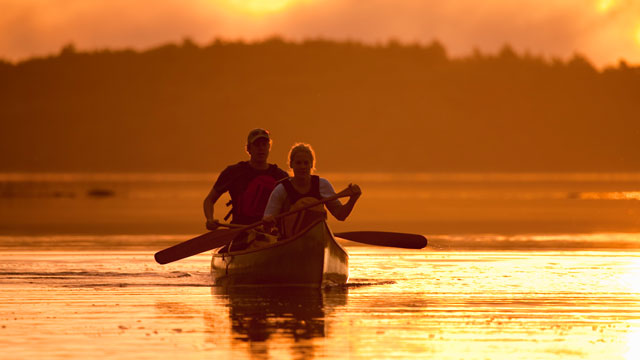
Canoeing, kayaking and stand-up paddleboarding (SUP)
Kejimkujik National Park and National Historic Site
Kejimkujik offers some of the best paddling in Atlantic Canada. Canoe, kayak, or paddleboard waters travelled by the Mi’kmaq for thousands of years. Paddling is for everyone – even for those with little or no experience! Bring your own equipment or rent a canoe, kayak, or stand-up paddleboard (plus safety equipment).
Fall, winter, and spring conditions
Keep in mind the following seasonal water hazards:
- cold water, near-zero air temperatures, and strong winds (risk of hypothermia)
- higher than normal water levels and strong currents on the rivers
Emergencies: Call 911 and be prepared to wait for help to arrive.
Guided experiences
Self-guided day trips
From Jake's Landing (1-2 hours)
The trip up river is excellent for families and those with little experience.
A one to two-hour trip up the quiet Mersey River takes you beneath overhanging red maples and through the home of turtles.
In small side streams, frogs and water lilies abound; watch them but leave them undisturbed. If you are quiet, you might see an elegant great blue heron.
An evening canoe outing may offer you a glimpse of beavers.
Down river leads to Kejimkujik Lake and its many islands, where you can spend hours watching water birds or exploring coves.
From lower Mersey River at the Eel Weir Bridge (2-4 hours)
A short (200-metre) portage takes you upstream to George Lake, a great place to explore among the islands (2 hours).
Search the lake for ducks and loons diving for fish, or deer feeding on the shoreline.
This lake remains sheltered from most strong winds.
If you canoe further northward, looping around Hemlock Island, you will see the expanse of Kejimkujik Lake.
Turn into Minards Bay where the landscape changes to large granite boulders in a bay dotted by islands and ringed by a rugged shoreline.
From Big Dam Lake (2-3 hours)
A 400-metre portage from the Big Dam parking lot takes you to Big Dam Lake.
The entire lakeshore is forested, with impressive pine and hemlock stands on the eastern side.
The lake is divided into two halves; the clear spring-fed southeastern half allows you to gaze at water lilies rooted in the shallows. This part of the lake usually remains sheltered from strong winds.
Paddle through the narrow passage and enter the northern expanse of this lake with its bog-fed dark-brown waters.
From Mersey River at the Visitor Centre (90 minutes)
Launch your canoe from the little dock just behind the Visitor Centre and take a short, leisurely trip up the Mersey River.
Explore this stillwater carefully, watching for signs of beaver or muskrat among the lushly vegetated islands.
Wilderness canoeing
Canoeing is the best way to experience and explore the backcountry at Kejimkujik.
Equipment rentals
Equipment rentals are available from Whynot Adventure, the Keji Outfitters.
Reservations 24 hours in advance are recommended.
Pick up your rental at Jake’s Landing.
Paddling safety
Be prepared
Navigation buoys will no longer be on Kejimkujik Lake. Visitors must come prepared to navigate to their campsite via map and compass and GPS enabled device.
Plan your outing
Check the updated weather forecast and talk to staff at the entrance kiosk or at Jakes Landing about paddling conditions.
Wind and waves on Kejimkujik Lake are often strongest at mid-day. For your safety we suggest paddling either early morning or late afternoon.
Foul weather and high winds may force you to stay put until conditions permit safe canoeing. Ensure your outing allows for extra time and provisions.
"Get informed and go outdoors" with the AdventureSmart program.
What to bring
Each person must have a properly fitting personal flotation device.
Each canoe or kayak must be equipped with a bailer, a whistle, and a 15 m buoyant rope.
Dress for all weather. Ensure you have hats, sunscreen, and clothing for changing conditions.
Visitor guidelines
Help keep Kejimkujik wild and beautiful!
For the welfare of all wildlife, always observe them from a distance. Leave nature undisturbed for others to enjoy.
Pack-out everything you pack-in. Learn more about the Leave No Trace Canada program.
Use only designated picnic sites – open fires are not permitted in these locations.
Backcountry campsites are for registered campers only – please respect campers’ privacy.
- Date modified :



